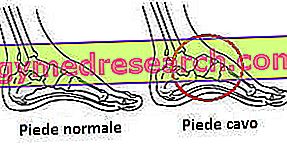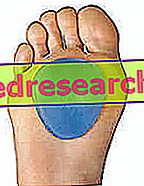Generality
Metatarsalgia is a disorder of the foot, characterized by a painful sensation at the metatarsal bones (which together form the so-called forefoot).

To trigger its appearance, usually, a set of factors intervenes, which, if taken individually, would hardly cause the same painful symptoms.
The diagnosis of metatarsalgia requires an accurate physical examination and a careful analysis of the patient's clinical history. Based on the results of diagnostic research, it is possible to establish the most appropriate conservative therapy. Surgical treatment is a very remote possibility, which is practiced only in very serious cases.
Short reference to the anatomy of the foot
Before describing metatarsalgia, it is useful to remind readers of the bone structure of the foot.
The foot is composed mainly of:
- Tarsal bones
- Metatarsal bones
- Phalanges
The tarsal bones, taken together, are 7 and make up a structure called tarsus . They are classified as large bones. On the one hand, they are connected with the tibia and the fibula (the connecting tarsal bone is the heel ); on the other, with metatarsal bones.

The phalanges are also 5 and correspond to the toes. Each finger is composed of 3 phalanges, except the big toe, which has only 2 phalanges.
What is metatarsalgia?
Metatarsalgia is a painful, inflammatory nature, located at the forefoot level, exactly at the metatarsal bones.
Epidemiology
Metatarsalgia can affect anyone. However, according to several epidemiological studies, it is more common among women who wear high heels, among overweight individuals, among those with severe anatomic deformities, among those suffering from rheumatoid arthritis or gout and between those who practice sports, such as walking or running, at good levels.
Causes
Only rarely, metatarsalgia is due to a single reason. In most cases, in fact, it is the result of a competition of causes, sometimes very different from each other.
A complete picture of all possible triggers is shown in the following list:
- Very intense training or physical activity . Medium-high level athletes who train daily tend to suffer from metatarsalgia. The most risky sports activities are running, tennis, basketball, football and baseball, as they are all sports that require a lot of running, the use of special footwear and, finally, the continuous impact on a hard surface or disconnected.
For an amateur athlete, the dangers are lower, but other favoring factors (for example overweight) can more easily take over.
- Some deformities of the congenital or acquired feet . The hollow foot, the hammer toes and the hallux valgus are the main defects of the feet that contribute to the appearance of metatarsalgia.

Figure : a normal foot compared to a hollow foot . As evidenced by the red circle, a hollow foot has a very pronounced plantar arch, which prevents it from resting with the middle part of the foot. This leads, in the long run, to a bad distribution of body weight (which concentrates on the heel and anterior part of the foot) and a modification of the position of the metatarsal bones. Overweight and obesity . The excess body weight of obese or overweight people affects lower limbs due to gravity. This leads to greater stress on the knees, ankles and feet, and an increased predisposition to all types of injuries, including metatarsalgia.
- Wear certain types of shoes . The shoes that most favor metatarsalgia are heeled shoes, worn by women, and shoes required in certain sports.
Furthermore, even shoes that are too tight seem to play a decisive role.
- Stress fractures . The after-effects of stress fractures on the feet (ie minor bone fractures caused by repeated micro-traumas) can cause the person who has suffered from them to take an incorrect walk that goes to overload the forefoot. This could cause the appearance of metatarsalgia, even after some time.
- Morton's neuroma . Morton's neuroma is a very painful disorder that affects the interdigital nerves of the feet (the interdigital nerves of the feet are the nerve endings placed between the various metatarsals).
- sore ankle or Achilles tendon inflamed . To get relief from these disorders, sufferers tend to take a walk other than normal. This can lead to an overload of the forefoot and the appearance of metatarsalgia.
- Freiberg disease . Also known as metatarsal osteochondrosis, it causes a process of necrosis that affects the second metatarsal of the foot.
- Diabetes . One of the main complications of diabetes is the degeneration of the nerve endings, which reach to the feet (including fingers). To learn more, you can consult the article on the website dedicated to diabetic foot.
- Rheumatoid arthritis or gout . They are two inflammatory diseases of the joints that can give rise to severe pain in the ankles and forefoot.
The concept of competition of causes is easier to explain with some examples.
Those who, in addition to suffering from obesity, also suffer from diabetes and / or have the habit of wearing the wrong shoes are more prone to metatarsalgia; or those who, with the Achilles tendon inflamed, continue to train and play sports without observing a rest period.
Symptoms and Complications
The typical symptom of metatarsalgia is pain in the forefoot . This sensation, of variable intensity, can be acute, deaf or burning, and tends to worsen for many hours while standing, running or walking for a long time.
Other characteristic symptoms of metatarsalgia, however less common than forefoot pain, are:
- Shooting pains, tingling and numbness in the toes
- Feeling of having pebbles in your shoes
APPEARANCE OF SYMPTOMS
Metatarsalgia may appear gradually, but also quite suddenly.
The gradual appearance is common in cases of overweight / obesity, rheumatoid arthritis and deformity of the feet. The sudden onset, on the other hand, is more frequent among those who decide to radically change some of their daily habits, for example moving from a sedentary life to an intense sporting activity, or starting to wear everyday types of shoes never worn before .
WHEN TO REFER TO THE DOCTOR
Before requesting a medical consultation for pain in the forefoot, it is advisable to keep the sore foot at rest for a short period; in fact, many times the problems of metatarsalgia are mild and are resolved with simple tricks (for example, avoiding shoes with heels, shoes that are too tight, long walks etc.).
If, however, despite this, painful sensations do not pass or even worsen, then it becomes very important to seek medical attention for a thorough examination.
COMPLICATIONS
Metatarsalgia, if neglected or poorly treated, can lead to a worsening of pain in the affected foot and / or the onset of back or hip problems.
Diagnosis
Many foot disorders cause the same symptoms. Therefore, for a correct diagnosis of metatarsalgia, a careful objective examination is required, in which all the factors that favor this forefoot disorder are sought.
EXAMINATION OBJECTIVE
During the physical examination, the doctor first asks the patient to describe the symptoms, their general characteristics and when they first started.
After that, he goes on to analyze clinical history, looking for something (pathologies suffered in the past, current disorders, habits, etc.) that can be traced back to the appearance of metatarsalgia.
Finally, if these findings reveal the possibility that at the origin of metatarsalgia there may be a serious pathological condition (such as a bone fracture or rheumatoid arthritis), it prescribes further diagnostic tests, such as X-ray examination or blood tests .
Treatment
Metatarsalgia usually requires conservative therapy. However, if the symptoms are severe and the triggers tend to worsen, as in the case of foot deformities, the only possible solution is surgery.
CONSERVATIVE THERAPEUTIC TREATMENT
Conservative therapy includes:
- Rest . Resting of the affected foot is one of the best remedies, regardless of the reasons for the onset of metatarsalgia. If a person is overweight and needs to lose weight, he can practice sports, such as swimming or cycling, which involve less stress to the detriment of the lower limbs.
- Ice packs on the suffering foot . The application of ice 4-5 times a day, for at least 20 minutes per pack, is an excellent analgesic solution (ie against pain). The ice-resting combination is called the RICE protocol, where R stands for rest (in English it is "rest") and ICE for ice.
- Elevation of the suffering limb . To reduce stress on the limb, it is good to keep the suffering foot raised, compatibly with the activities carried out during the day.
- Taking painkillers and anti-inflammatories as needed . When the pain is very acute and intolerable, it is recommended to take drugs with pain-relieving and anti-inflammatory powers, such as NSAIDs (non-steroidal anti-inflammatory drugs), paracetamol or cortisone drugs. Attention: the cortisone drugs, which are very powerful anti-inflammatory drugs, should be taken only on medical prescription, as their inadequate administration can cause unpleasant side effects.
- Wear appropriate shoes . If the shoes worn daily are responsible for metatarsalgia, it is good to change the type of footwear. If a suitable solution cannot be found, it is advisable to consult a podiatrist, that is an expert in the treatment and prevention of foot pathologies.
- Apply antishock insoles, inside the shoes usually worn . There are insoles in rubber, gel or cork, which, if applied in shoes worn every day, reduce the impact of the foot against the ground.

Figure : a footbed for the forefoot This remedy is particularly important for runners, walkers and for all those who practice sports on a hard surface.
- Bring appropriate insoles for the hollow foot . Those who suffer from hollow foot can resort to the use of special orthotics, which serve to normalize the anomalous plantar arch and to guarantee a more appropriate foot support.
- Treatment of favoring pathologies . The symptoms of metatarsalgia due to diabetes, rheumatoid arthritis, gout or overweight / obesity are also mitigated by treating (as much as possible, of course) the aforementioned pathologies.
SURGICAL TREATMENT
Surgery to resolve metatarsalgia is a therapeutic solution that is rarely considered and only in the absence of other effective remedies.
The operation is in fact reserved for very severe foot deformities and cases of Morton's neuroma characterized by severe and long-standing symptoms.
Prevention
Three good tips to prevent metatarsalgia are:
- Wear appropriate shoes
- Provide the footwear with anti-shock or appropriate insoles
- Lose excess weight
Shoes, as mentioned several times, play a decisive role, therefore it is good to choose a pair suitable for the characteristics of the foot (especially if you are a medium-high level sportsman or if you intend to start a sport like running).
The antishock insoles reduce the effects of the impact with the ground, while the orthotics reshape the feet affected by particular deformities.
Finally, losing the extra pounds reduces the load on the lower limbs, especially in the knees, ankles and feet.
ADVICE FOR SPORTS: HOW TO PREVENT RELATIONS
To prevent the reappearance of metatarsalgia, it is good to have patience and resume activities only when the pain has completely disappeared.





